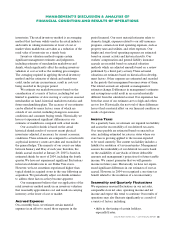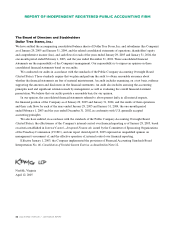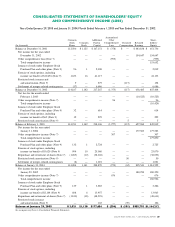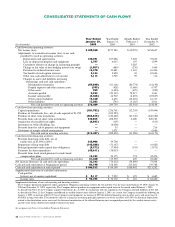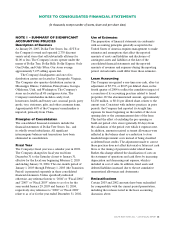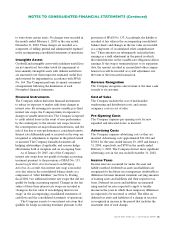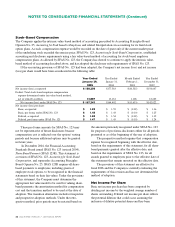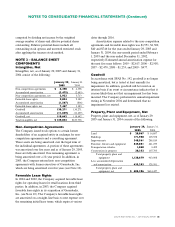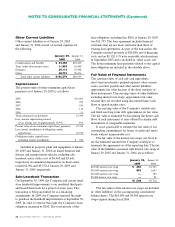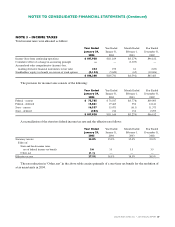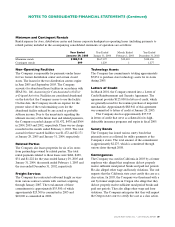Dollar Tree 2004 Annual Report Download - page 35
Download and view the complete annual report
Please find page 35 of the 2004 Dollar Tree annual report below. You can navigate through the pages in the report by either clicking on the pages listed below, or by using the keyword search tool below to find specific information within the annual report.
DOLLAR TREE STORES, INC. • 2004 ANNUAL REPORT 31
NOTE 1 – SUMMARY OF SIGNIFICANT
ACCOUNTING POLICIES
Description of Business
At January 29, 2005, Dollar Tree Stores, Inc. (DTS or
the Company) owned and operated 2,735 discount
variety retail stores that sell substantially all items for
$1.00 or less. The Company’s stores operate under the
names of Dollar Tree, Dollar Bills, Dollar Express, Only
One Dollar, and Only $One. Our stores average
approximately 7,475 selling square feet.
The Company’s headquarters and one of its
distribution centers are located in Chesapeake, Virginia.
The Company also operates distribution centers in
Mississippi, Illinois, California, Pennsylvania, Georgia,
Oklahoma, Utah, and Washington. The Company’s
stores are located in all 48 contiguous states. The
Company’s merchandise includes candy, food,
housewares, health and beauty care, seasonal goods, party
goods, toys, stationery, gifts, and other consumer items.
Approximately 40% of the Company’s merchandise is
imported, primarily from China.
Principles of Consolidation
The consolidated financial statements include the
financial statements of Dollar Tree Stores, Inc., and
its wholly owned subsidiaries. All significant
intercompany balances and transactions have been
eliminated in consolidation.
Fiscal Year
The Company’s fiscal year was a calendar year in 2002.
The Company changed its fiscal year end from
December 31 to the Saturday closest to January 31,
effective for the fiscal year beginning February 2, 2003
and ending January 31, 2004. The one-month period of
January 1, 2003 through February 1, 2003 (the Transition
Period) is presented separately in these consolidated
financial statements. Unless specifically indicated
otherwise, any reference herein to “2004” or “Fiscal 2004”
and “2003”or “Fiscal 2003”relates to as of or for the
years ended January 29, 2005 and January 31, 2004,
respectively. Any references to “2002” or “Fiscal 2002”
relate to as of or for the year ended December 31, 2002.
Use of Estimates
The preparation of financial statements in conformity
with accounting principles generally accepted in the
United States of America requires management to make
estimates and assumptions that affect the reported
amounts of assets and liabilities and disclosures of
contingent assets and liabilities at the date of the
consolidated financial statements and the reported
amounts of revenues and expenses during the reporting
period. Actual results could differ from those estimates.
Lease Accounting
The Company recognized a one-time non-cash, after-tax
adjustment of $5,751, or $0.05 per diluted share, in the
fourth quarter of 2004 to reflect the cumulative impact of
a correction of its accounting practices related to leased
properties. Of the aforementioned amount, approximately
$1,230 million, or $0.01 per diluted share, relates to the
current year. Consistent with industry practices, in prior
periods, the Company had reported its straight line
expenses for leases beginning on the earlier of the store
opening date or the commencement date of the lease.
This had the effect of excluding the pre-opening or
build-out period of its stores (generally 60 days) from
the calculation of the period over which it expenses rent.
In addition, amounts received as tenant allowances were
reflected in the balance sheet as a reduction to store
leasehold improvement costs instead of being classified
as deferred lease credits. The adjustment made to correct
these practices does not affect historical or future net cash
flows or the timing of payments under related leases.
Rather, this change affected the classification of costs on
the statement of operations and cash flows by increasing
depreciation and decreasing rent expense, which is
included in cost of sales. In addition, fixed assets and
deferred liabilities increased due to the net cumulative
unamortized allowances and abatements.
Reclassifications
Certain 2003 and 2002 amounts have been reclassified
for comparability with the current period presentation,
including the reclasses noted in the lease accounting
discussion above.
NOTES TO CONSOLIDATED FINANCIAL STATEMENTS
(In thousands, except number of stores, share and per share data)




